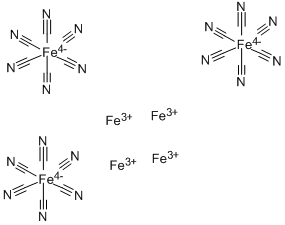
Prussian blue is an orally active compound that is also used as an antidote for poisoning by certain heavy metals, such as radioactive cesium or thallium ions, and as a contrast agent in magnetic resonance imaging (MRI). It also has anticancer and antibacterial properties. It can be used in contrast agent, antidote and cancer related research.
| Molecular Weight | 859.23 |
| Formula | C18Fe7N18 |
| CAS Number | 14038-43-8 |
| Form | Solid |
| Solubility (25°C) | Water 6 mg/mL |
| Storage |
Powder -20°C 3 years ; 4°C 2 years In solvent -80°C 6 months ; -20°C 1 month |
| Species | Mouse | Rat | Rabbit | Guinea pig | Hamster | Dog |
| Weight (kg) | 0.02 | 0.15 | 1.8 | 0.4 | 0.08 | 10 |
| Body Surface Area (m2) | 0.007 | 0.025 | 0.15 | 0.05 | 0.02 | 0.5 |
| Km factor | 3 | 6 | 12 | 8 | 5 | 20 |
| Animal A (mg/kg) = Animal B (mg/kg) multiplied by | Animal B Km |
| Animal A Km |
For example, to modify the dose of Compound A used for a mouse (20 mg/kg) to a dose based on the BSA for a rat, multiply 20 mg/kg by the Km factor for a mouse and then divide by the Km factor for a rat. This calculation results in a rat equivalent dose for Compound A of 10 mg/kg.
| Related Products |
|---|
| PRGL493
PRGL493 is a potent and selective long-chain acyl-CoA synthetase 4 (ACSL4) inhibitor. PRGL493 blocks cell proliferation and tumor growth in both breast and prostate cellular and animal models. |
| Hercynine
Hercynine is a natural product, found in the fine leaf algae, Schizosaccharomyces cerevisiae and honey bees, and is a precursor of L-(+)-ergothioneine. |
| C24-Ceramide
C24 Ceramide (Lignoceric ceramide) is a naturally occurring ceramide and an integral part of the sphingomyelin cycle. C24 Ceramide (Lignoceric ceramide) stimulates the proliferation of basophilic erythroblasts, suggesting a possible role in erythrocyte maturation. |
| RNA-protein crosslinking (sulfhydryl addition) agent
RNA-protein crosslinking (sulfhydryl addition) agent is a thiolating agent that is useful in cross-linking proteins. Thiolan-2-imine hydrochloride is a reagent for the introduction of sulphydryl groups into oligosaccharides derived from asparagine-linked glycans. |
| Izeltabart
Izeltabart is a high-affinity humanized antibody targeting ADAM9. Izeltabart can be used as ADC Antibody for site-specific conjugation with Maytansinoid-based DM21-C to synthesize IMGC936, an Antibody-drug Conjugate with strong anti-cancer activity. IMGC936 exhibits cytotoxicity against ADAM9-positive human tumor cell lines and potent antitumor activity in xenograft tumor models. |


Products are for research use only. Not for human use. We do not sell to patients.
© Copyright 2010-2023 AbMole BioScience. All Rights Reserved.
